Willingness to Pay for More Sustainable Tourism Destinations in World Heritage Cities: The Case of Caceres, Spain
Abstract
1. Introduction
2. The Willingness to Pay for Cultural Heritage and Sustainable Tourism
3. Case Study: The City of Caceres as a Tourism Destination
4. Methodology
5. Results
5.1. WTP from a Global Approach
5.2. Influence of Determining Factors on WTP
6. Discussion of Results
7. Conclusions
Author Contributions
Acknowledgments
Conflicts of Interest
Appendix A
| Origin: |
| □ Spain (Indicate Autonomous Community of origin) …………………………………………………. |
| □ Foreigner (Indicate country of origin) …………………………………………………………………… |
| Gender: |
| □ Female |
| □ Male |
| Age: |
| □ From 18 to 25 years old □ From 26 to 40 y/o □ From 41 to 55 y/o |
| □ From 56 to 65 y/o □ Older than 66 y/o. |
| Educational level: |
| □ No studies □ Primary studies □ High School □ College/University. |
| 1. Do you believe that good practices regarding sustainability raise the price of the tourist service? |
| □ Yes. |
| □ No. |
| 2. Would you be willing to pay a raise on the price of a tourist service to enjoy your stay in a more sustainable destination? |
| □ Yes. (Go to question nº 3). |
| □ No. (Go to question nº 4). |
| 3. Which quantity would you be willing to pay in order to enjoy a more sustainable tourist service in the following cases? (Cross the desired answer) |
| a) On a double hotel room: |
| (0 euros/1euro/2 euros/5 euros/10 euros/15 euros/20 euros/25 euros/30 euros/50 euros). |
| b) On a restaurant: |
| (0 euros/0.5 euros/1 euro/2 euros/3 euros/4 euros/5 euros/7.5 euros/10 euros/15 euros). |
| c) On the ticket to a museum: |
| (0 euros/0.1 euros/0.25 euros/0.50 euros/0.75 euros/1 euro/1.25 euros/1.50 euros/1.75 euros/2 euros). |
| d) On a taxi drive: |
| (0 euros/0.5 euros/1 euro/1.5 euros/2 euros/2.5 euros/3 euros/3.5 euros/4 euros/5 euros). |
References
- United Nations World Tourism Organization (UNWTO). Baseline Report on the Integration of Sustainable Consumption and Production Patterns into Tourism Policies. Available online: https://www.e-unwto.org/doi/pdf/10.18111/9789284420605 (accessed on 15 June 2019).
- Zhang, J.J.; Joglekar, N.R.; Verma, R. Exploring resource efficiency benchmarks for environmental sustainability in hotels. Cornell Hosp. Q. 2012, 53, 229–241. [Google Scholar] [CrossRef]
- Leonidou, L.C.; Leonidou, C.N.; Fotiadis, T.A.; Zeriti, A. Resources and capabilities as drivers of hotel environmental marketing strategy: Implications for competitive advantages and performance. Tour. Manag. 2013, 35, 94–110. [Google Scholar] [CrossRef]
- Kang, K.H.; Stein, L.; Heo, C.Y.; Lee, S. Consumers’ willingness to pay for green initiatives of the hotel industry. Int. J. Hosp. Manag. 2011, 31, 564–572. [Google Scholar] [CrossRef]
- Dimara, E.; Mangarini, E.; Skuras, D. Consumers’ willingness to pay premium for green hotels: Fact or Fad? In Proceedings of the International Marketing Trends Conference 2015, Paris, France, 22–24 January 2014. [Google Scholar]
- Masau, P.; Prideaux, B. Sustainable tourism: A role for Kenya’s hotel industry. Curr. Issues Tour. 2003, 6, 197–208. [Google Scholar] [CrossRef]
- Kelly, J.; Haider, W.; Williams, P.W.; Englund, K. Stated preferences of tourists for ecoefficient destination planning options. Tour. Manag. 2007, 28, 377–390. [Google Scholar] [CrossRef]
- Han, H.; Hsu, L.-T.; Lee, J.-S. Empiricial investigation of the roles of attitudes toward Green behaviours, overall image, gender, and age in hotel customers’ eco-friendly decision-making process. Int. J. Hosp. Manag. 2009, 28, 519–528. [Google Scholar] [CrossRef]
- Manaktola, K.; Jauhari, V. Exploring consumer attitude and behavior towards green practices in the lodging industy in India. Int. J. Contemp. Hosp. Manag. 2007, 19, 364–377. [Google Scholar] [CrossRef]
- Han, X.; Chan, K. Perception of green hotels among tourists in Hong Kong: An exploratory study. Serv. Mark. Q. 2013, 34, 339–352. [Google Scholar] [CrossRef]
- Pearce, D.; Ozdemmiroglu, E. Economic Valuation with Stated Preferences Techniques; Department of Transport, Local Government and the Regions: London, UK, 2002.
- Throsby, D. Cultural capital. J. Cult. Econ. 1999, 23, 3–12. [Google Scholar] [CrossRef]
- Tuan, T.; Navrud, S. Capturing the benefits of preserving cultural heritage. J. Cult. Herit. 2008, 9, 326–337. [Google Scholar] [CrossRef]
- Báez, A.; Herrero, L.C. Using contingency valuation and cost-benefit analysis to design a policy for restoring cultural heritage. J. Cult. Herit. 2012, 13, 235–245. [Google Scholar] [CrossRef]
- Choi, A.S.; Ritchie, B.W.; Papandrea, F.; Benett, J. Economic valuation of cultural heritage sites: A choice modeling approach. Tour. Manag. 2010, 31, 213–220. [Google Scholar] [CrossRef]
- Bateman, I.J.; Carson, R.T.; Day, B.; Hanemann, M.; Hanley, N.; Hett, T.; Jones-Lee, M.; Loomes, G. Economic Valuation with Stated Preference Techniques: A Manual; Edward Elgar: Northampton, MA, USA, 2002. [Google Scholar]
- Carson, R.T.; Flores, N.E.; Meade, N.F. Contingent valuation: Controversies and evidence. Environ. Resour. Econ. 2001, 19, 173–210. [Google Scholar] [CrossRef]
- Martín, F. Determining the size of museum subsidies. J. Cult. Econ. 1994, 18, 255–270. [Google Scholar] [CrossRef]
- Sanz, J.A.; Herrero, L.C.; Bedate, A.M. Contingent valuation and semiparametric methods: A case study of the National Museum of Sculpture in Valladolid, Spain. J. Cult. Econ. 2003, 27, 241–257. [Google Scholar] [CrossRef]
- Bedate, A.M.; Herrero, L.C.; Sanz, J.A. Ex ante and ex post valuations of a cultural good. Are preferences or expectations changing? Environ. Plan. Manag. 2012, 55, 127–140. [Google Scholar] [CrossRef]
- Gómez-Zapata, J.D.; Espinal-Monsalve, N.E.; Herrero-Prieto, L.C. Economic valuation of museums as public club goods: Why build loyalty in cultural heritage consumption? J. Cult. Herit. 2018, 30, 190–198. [Google Scholar] [CrossRef]
- Madison, D.; Mourato, S. Valuing different road options for Stonehenge. Conserv. Manag. Archaeol. Sites 2001, 4, 203–212. [Google Scholar] [CrossRef]
- Carson, R.T.; Mitchell, R.C.; Conaway, M.C. Economic benefits to foreigners visiting Morocco accruing from the rehabilitation of the Fes Medina. In Valuing Cultural Heritage: Applying Environmental Valuation Techniques to Historic Buildings, Monuments and Artifacts; Navrud, S., Ready, R.C., Eds.; Edward Elgar: Northampton, MA, USA, 2002. [Google Scholar]
- Mazzanti, M. Valuing cultural heritage services by choice modeling experiments: Visitor study at the Galleria Borghese in Rome. In Proceedings of the 12th Biennial ACEI Conference, Rotterdam, The Netherlands, 13–15 June 2002. [Google Scholar]
- Mourato, S.; Kontoleon, A.; Danchev, A. Preserving cultural heritage in transition economies: A contingent valuation studies of Bulgarian monasteries. In Valuing Cultural Heritage: Applying Environmental Valuation Techniques to Historic Buildings, Monuments and Artifacts; Navrud, S., Ready, R.C., Eds.; Edward Elgar: Northampton, MA, USA, 2002. [Google Scholar]
- Gurira, N.A.; Ngulube, P. Using contingency valuation approaches to assess sustainable cultural heritage tourism use and conservation of the outstanding universal values (OUV) at Great Zimbabwe World Heritage Site in Zimbabwe. Procedia Soc. Behav. 2016, 225, 291–302. [Google Scholar] [CrossRef]
- Kim, H.; Oh, C.; Lee, S.; Lee, S. Assessing the economic values of World Heritage Sites and the effects of perceived authenticity on their values. Int. J. Tour. Res. 2017, 20, 126–136. [Google Scholar] [CrossRef]
- Hansen, T. The willingness to pay for the royal theatre in Copenhagen as a public good. J. Cult. Econ. 1997, 21, 1–28. [Google Scholar] [CrossRef]
- Santagata, W.; Signorello, G. Contingent valuation and cultural policy design: The case of Napoli Musei Aperti. J. Cult. Econ. 2000, 24, 315–331. [Google Scholar] [CrossRef]
- Kopsidas, O. The opportunity cost as a critical determinant factor of the cultural heritage monuments’ valuation: A modified contingent valuation method. J. Environ. Sci. Eng. B 2018, 7, 55–64. [Google Scholar] [CrossRef]
- Georgiou, S.; Langford, I.H.; Bateman, I.J.; Turner, R.K. Determinants of individuals’ willingness to pay for perceived reductions in environmental health risks: A case study of bathing water quality. Environ. Plan. A 1998, 30, 577–594. [Google Scholar] [CrossRef]
- Preibler, S. Evaluation of the quality of European coastal water by German tourists. In Coastal Change in the Southern Baltic Sea Region, Coastline Reports; Schernewski, G., Janben, H., Schumacher, S., Eds.; EUCC—The Coastal Union: Leiden, The Netherlands, 2009; Volume 13, pp. 177–186. [Google Scholar]
- Machado, F.; Mourato, S. Improving the assessment of water related health impacts: Evidence from coastal waters in Portugal. In Proceedings of the First World Congress on Environmental and Resource Economics, Venice, Italy, 25–27 June 1998. [Google Scholar]
- Beharry-Borg, N.; Scarpa, R. Valuing quality changes in Caribbean coastal waters for heterogeneous beach visitors. Ecol. Econ. 2010, 69, 1124–1139. [Google Scholar] [CrossRef]
- Peng, M.; Oleson, K.L. Beach recreationalists’ willingness to pay and economic implications of coastal water quality problems in Hawaii. Ecol. Econ. 2017, 136, 41–52. [Google Scholar] [CrossRef]
- Hess, S.; Beharry-Borg, N. Accounting for latent attitudes in willingness-to-pay studies: The case of coastal water quality improvements in Tobago. Environ. Resour. Econ. 2012, 52, 109–131. [Google Scholar] [CrossRef]
- Ünal, Ö.; Williams, A.T. Beach visits and willingness to pay: Cesme Peninsula, Turkey. In Proceedings of the MEDCOASTEMECS 99 Joint Conference, Land-Ocean Interactions: Managing Coastal Ecosystems, Antalya, Turkey, 9–13 November 1999; pp. 1149–1162. [Google Scholar]
- Blakemore, F.B.; Williams, A.T.; Ozhan, E. Tourist valuation of Olu Deniz beach, Turkey, using contingent valuation and travel coast approaches. J. World Leis. 2000, 4, 48–55. [Google Scholar] [CrossRef]
- Blakemore, F.B.; Williams, A.T.; Micallef, A.; Conan, C.; Ünal, Ö. A comparison of tourist evaluation of beaches in Malta, Romania and Turkey. J. World Leis. 2002, 44, 29–41. [Google Scholar] [CrossRef][Green Version]
- Togridou, A.; Hovardas, T.; Pantis, J.D. Determinants of visitors’ willingness to pay for the National Marine Park of Zalynthos, Greece. Ecol. Econ. 2006, 60, 308–319. [Google Scholar] [CrossRef]
- Blakemore, F.B.; Williams, A. British tourists’ valuation of a Turkish beach using contingent valuation and travel cost methods. J. Coast. Res. 2008, 24, 1469–1480. [Google Scholar] [CrossRef]
- Logar, I.; van den Bergh, J. Respondent uncertainty in contingent valuation of preventing beach erosion: An analysis with a polychotomous choice question. J. Environ. Manag. 2012, 113, 184–193. [Google Scholar] [CrossRef] [PubMed]
- Ariza, E.; Ballester, R.; Rigall-I-Torrent, R.; Saló, A.; Roca, E.; Villares, M.; Jiménez, J.A.; Sardá, R. On the relationship between quality, users’ perception and economic valuation in NW Mediterranean beaches. Ocean Coast. Manag. 2012, 63, 55–66. [Google Scholar] [CrossRef]
- Birdir, S.; Ünal, Ö.; Birdir, K.; Williams, A.T. Willingness to pay as an economic instrument for coastal tourism management: Cases for Mersin, Turkey. Tour. Manag. 2013, 36, 27–283. [Google Scholar] [CrossRef]
- Rodella, I.; Madau, F.; Mazzanti, M.; Corbau, C.; Carboni, D.; Utizi, K.; Simeoni, U. Willingness to pay for management and preservation of natural, semi-urban and urban beaches in Italy. Ocean. Coast. Manag. 2019, 172, 93–104. [Google Scholar] [CrossRef]
- Langford, I.H.; Kontogianni, A.; Skourtos, M.S.; Georgiou, S.; Bateman, I.J. Multivariate mixed models for openended contingent valuation data: Willingness to pay for conservation of monk seals. Environ. Resour. Econ. 1998, 12, 443–456. [Google Scholar] [CrossRef]
- Fan, Z. Investigating the Potential for a PES (Payment for Environmental Services) System for Marine Turtle Conservation: The Case of Protection of Marine Turtle Breeding Sites in Crete, Greece. Master’s Thesis, ITC, Enschede, The Netherlands, March 2008. [Google Scholar]
- Sayan, S.; Williams, A.T.; Johnson, D.E.; Ünal, Ö. A pilot study for sustainable tourism in the coastal zone of Antalya, Turkey: Tourists, turtles or both? J. Coast. Res. 2011, 64, 1806–1810. [Google Scholar]
- Shivlani, M.P.; Letson, D.; Theis, M. Visitor preferences for public beach amenities and beach restoration in South Florida. Coast. Manag. 2003, 31, 367–385. [Google Scholar] [CrossRef]
- Chang, J.I.; Yoon, S. Assessing the economic value of beach restoration: Case of Son-do beach, Korea. J. Coast. Res. 2017, 79, 6–10. [Google Scholar] [CrossRef]
- Matthews, Y.; Scarpa, R.; Marsh, D. Stability of willingness-to-pay for coastal management: A choice experiment across three time periods. Ecol. Econ. 2017, 138, 64–73. [Google Scholar] [CrossRef]
- Zang, F.; Wang, X.H.; Nunes, P.A.; Ma, C. The recreational value of gold coast beaches, Australia: An application of the travel cost method. Ecosyst. Serv. 2015, 11, 106–114. [Google Scholar] [CrossRef]
- Blignaut, J.; Mander, M.; Inglesi-Lotz, R.; Glavan, J.; Parr, S. The amenity value of Abu Dhabi’s coastal and marine resources to its beach visitors. Ecosyst. Serv. 2016, 19, 32–41. [Google Scholar] [CrossRef]
- Pragaya, P. Estimating the value of beach recreation for locals in the great barrier reef marine park, Australia. Econ. Anal. Policy 2017, 53, 9–18. [Google Scholar] [CrossRef]
- Enríquez-Acevedo, T.; Botero, C.M.; Cantero-Rodelo, R.; Pertuz, A.; Suárez, A. Willingness to pay for Beach Ecosystem Services: The case study of three Colombian beaches. Ocean. Coast. Manag. 2018, 161, 96–104. [Google Scholar] [CrossRef]
- Hultman, M.; Kazeminia, A.; Ghasemi, V. Intention to visit and willingness to pay premium for ecotourism: The impact of attitude, materialism, and motivation. J. Bus. Res. 2015, 68, 1854–1861. [Google Scholar] [CrossRef]
- Pedroso, R.; Kung’u, J.B. Tourists’ willingness to pay for upstream restoration and conservation measures. J. Sustain. Tour. 2019. [Google Scholar] [CrossRef]
- Cheung, L.T.O. The effect of geopark visitors’ travel motivations on their willingness to pay for accredited geo-guided tours. Geoheritage 2016, 8, 201–209. [Google Scholar] [CrossRef]
- Wang, P.-W.; Jia, J.-B. Tourists’ willingness to pay for biodiversity conservation and environment protection, Dalai Lake protected area: Implications for entrance fee and sustainable development. Ocean Coast. Manag. 2012, 62, 24–33. [Google Scholar] [CrossRef]
- Platania, M.; Rizzo, M. Willingness to pay for protected areas: A case of Etna Park. Ecol. Indic. 2018, 93, 201–206. [Google Scholar] [CrossRef]
- Namkung, Y.; Jang, S. Are consumers willing to pay more for green practices at restaurants? J. Hosp. Tour. Res. 2014. [Google Scholar] [CrossRef]
- Meleddu, M.; Pulina, M. Evaluation of individuals’ intention to pay for premium price for ecotourism: An exploratory study. J. Behav Exp. Econ. 2016, 65, 67–78. [Google Scholar] [CrossRef]
- López-Sánchez, Y.; Pulido-Fernández, J.I. Factor influencing the willingness to pay for sustainable tourism: A case of mass tourism destinations. Int. J. Sustain. Dev. World 2017, 24, 262–275. [Google Scholar] [CrossRef]
- Kostakis, I.; Sardianou, E. Which factors affect the willingness of tourists to pay for renewable energy? In Proceedings of the World Renewable Energy Congress, Linköping, Sweden, 8–13 May 2011; pp. 2578–2585. [Google Scholar]
- Van Liere, K.D.; Dunlap, R.E. The social bases of environmental concern: A review of hypotheses, explanations and empirical evidence. Public Opin. Q. 1980, 44, 181–197. [Google Scholar] [CrossRef]
- Daniere, A.G.; Takahashi, L.M. Environmental behavior in Bangkok, Thailand: A portrait of attitudes, values and behavior. Econ. Dev. Cult. Chang. 1999, 47, 552–557. [Google Scholar] [CrossRef]
- Arcury, T.A.; Scollay, S.J.; Johnson, T.P. Sex differences in environmental concern and knowledge: The case of acid rain. Sex Roles 1987, 16, 463–472. [Google Scholar] [CrossRef]
- Laroche, M.; Bergeon, L.; Barbaro-Forleo, G. Targeting consumers who are willing to pay more for environmentally friendly products. J. Consum. Mark. 2001, 18, 503–520. [Google Scholar] [CrossRef]
- Zeidner, M.; Shechter, M. Psychological responses to air pollution: Some personality and demographic correlates. J. Environ. Psychol. 1988, 8, 191–208. [Google Scholar] [CrossRef]
- Halkos, G.; Matsiori, S. Determinants of willingness to pay for coastal zone quality improvement. J. Socio Econ. 2012, 41, 391–399. [Google Scholar] [CrossRef]
- Alves, B.; Benavente, J.; Ferreira, O. Beach users’ profile, perceptions and willingness to pay for beach management in Cadiz (SW Spain). J. Coast. Res. 2014, 70, 521–526. [Google Scholar] [CrossRef]
- Cooper, P.; Poe, G.L.; Bateman, I.J. The structure of motivation for contingent values: A case study of lake water quality improvement. Ecol. Econ. 2004, 50, 69–82. [Google Scholar] [CrossRef]
- Sauer, U.; Fisher, A. Willingness to pay, attitudes and fundament values on the cognitive context of public preferences for diversity in agricultural landscapes. Ecol. Econ. 2010, 70, 1–9. [Google Scholar] [CrossRef]
- Ajzen, I. The theory of planned behavior. Organ. Behav. Hum. Decis. Process. 1991, 50, 179–211. [Google Scholar] [CrossRef]
- Bernath, K.; Roschewitz, A. Recreational benefits of urban forests: Explaining visitors’ willingness to pay in the context of the theory of planned behavior. J. Environ. Manag. 2008, 89, 155–166. [Google Scholar] [CrossRef] [PubMed]
- Spash, C.; Urama, K.; Burton, R.; Kenyon, W.; Shannon, P.; Hill, G. Motives behind willingness to pay for improving biodiversity in water ecosystems: Economics, ethics and social psychology. Ecol. Econ. 2009, 68, 955–964. [Google Scholar] [CrossRef]
- López-Mosquera, N.; García, T.; Barrena, R. An extension of the Theory of Planned Behavior to predict willingness to pay for the conservation of an urban park. J. Environ. Manag. 2014, 135, 91–99. [Google Scholar] [CrossRef] [PubMed]
- Yadav, R.; Pathak, G.S. Determinants of consumers’ green purchase behavior in a developing nation: Applying and extending the Theory of Planned Behavior. Ecol. Econ. 2017, 134, 114–122. [Google Scholar] [CrossRef]
- Shin, Y.H.; Im, J.; Jung, S.E.; Severt, K. Locally sourced restaurant: Consumer’s willingness to pay. J. Food Bus. Res. 2018, 21, 68–82. [Google Scholar] [CrossRef]
- Sánchez, M.; López-Mosquera, N.; Lera-López, F.; Faulin, J. An extended planned behavior model to explain the willingness to pay to reduce noise pollution in road transportation. J. Clean. Prod. 2018, 177, 144–154. [Google Scholar] [CrossRef]
- Tommasetti, A.; Singer, P.; Troisi, O.; Maione, G. Extented Theory of Planned Behavior (ETPB): Investigating customers’ perception of restaurants’ sustainability by testing a structural equation model. Sustainability 2018, 10, 2580. [Google Scholar] [CrossRef]
- Carson, R.T. Contingent valuation: A user’s guide. Environ. Sci. Technol. 2000, 34, 1413–1418. [Google Scholar] [CrossRef]
- Sanjurjo, E.; Islas, E.I. Valoración económica de la actividad recreativa en el río Colorado. Reg. Soc. 2007, 40, 147–172. [Google Scholar] [CrossRef]
- Martín-López, B.; Montes, C.; Benayas, J. The non economic motives behind the willingness to pay for biodiversity conservation. Biol. Conserv. 2007, 139, 67–82. [Google Scholar] [CrossRef]
- United Nations Environment Programme—UNEP. Guidance Manual for the Valuation of Regulating Services; UNEP: Nairobi, Kenya, 2010. [Google Scholar]
- López-Sánchez, Y.; Pulido-Fernández, J.I. Factores determinantes de la disposición a pagar por un destino más sostenible. El caso de la Costa del Sol Occidental. Cuad. Tur. 2014, 33, 199–231. [Google Scholar]
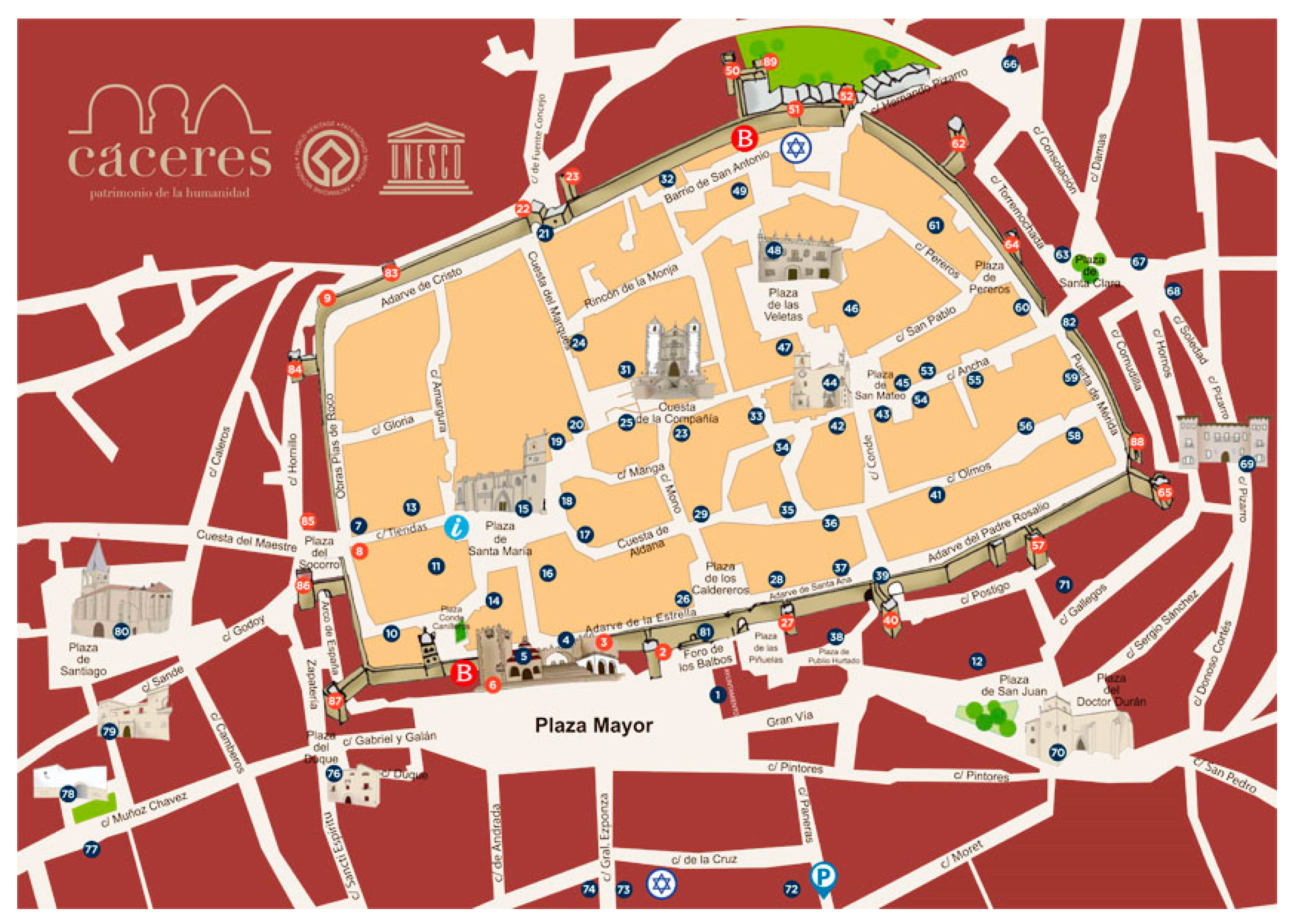
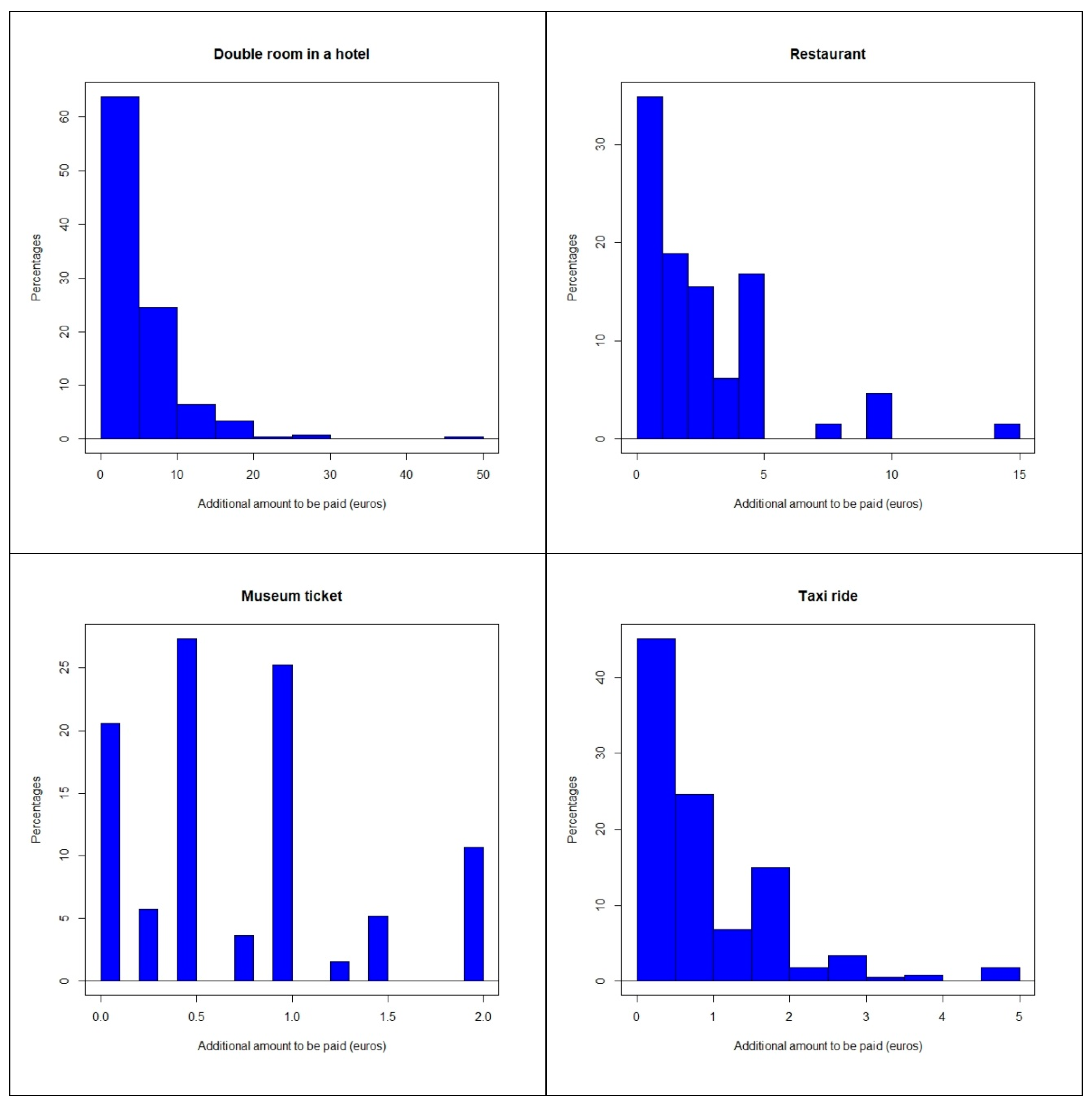
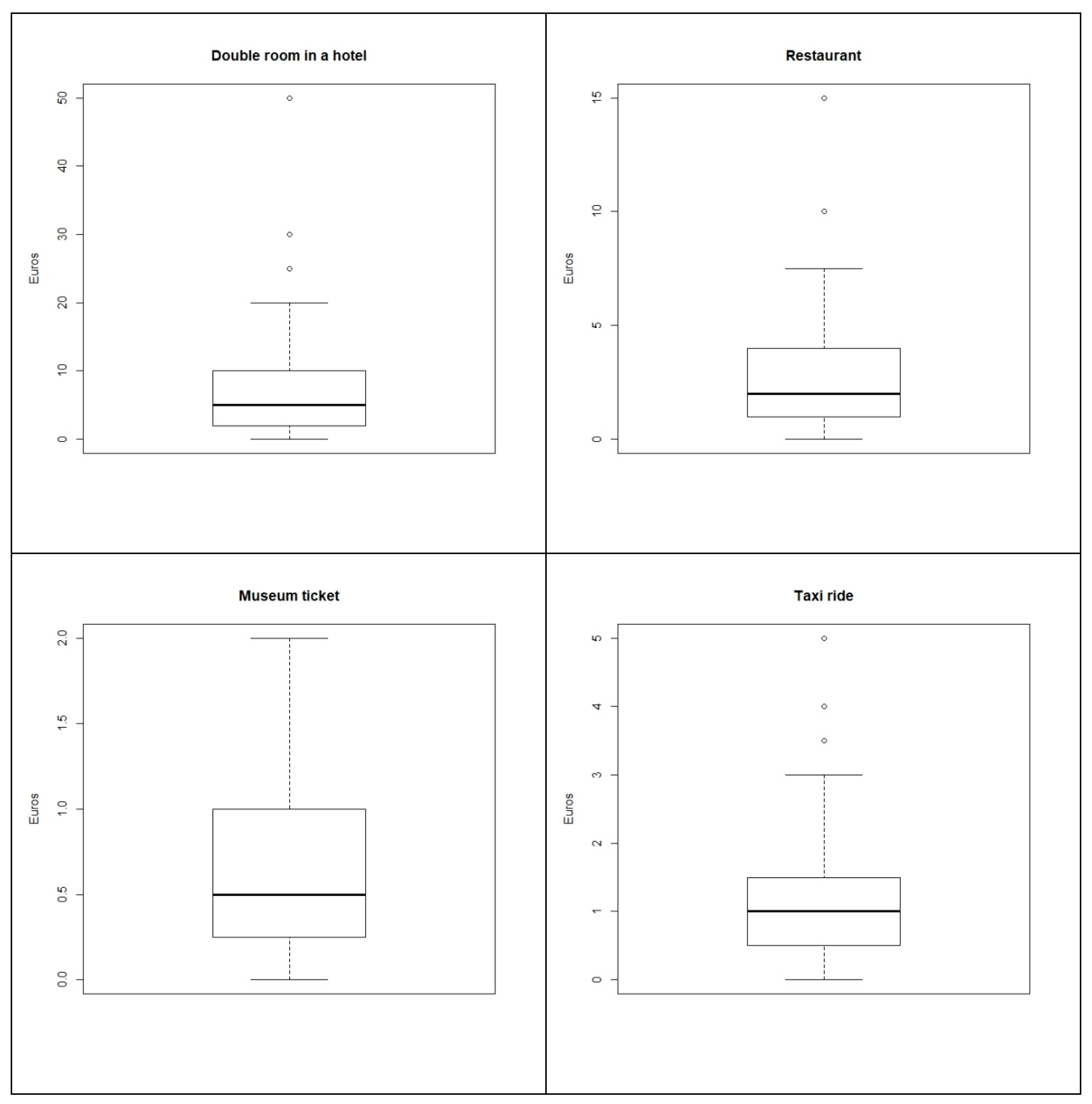
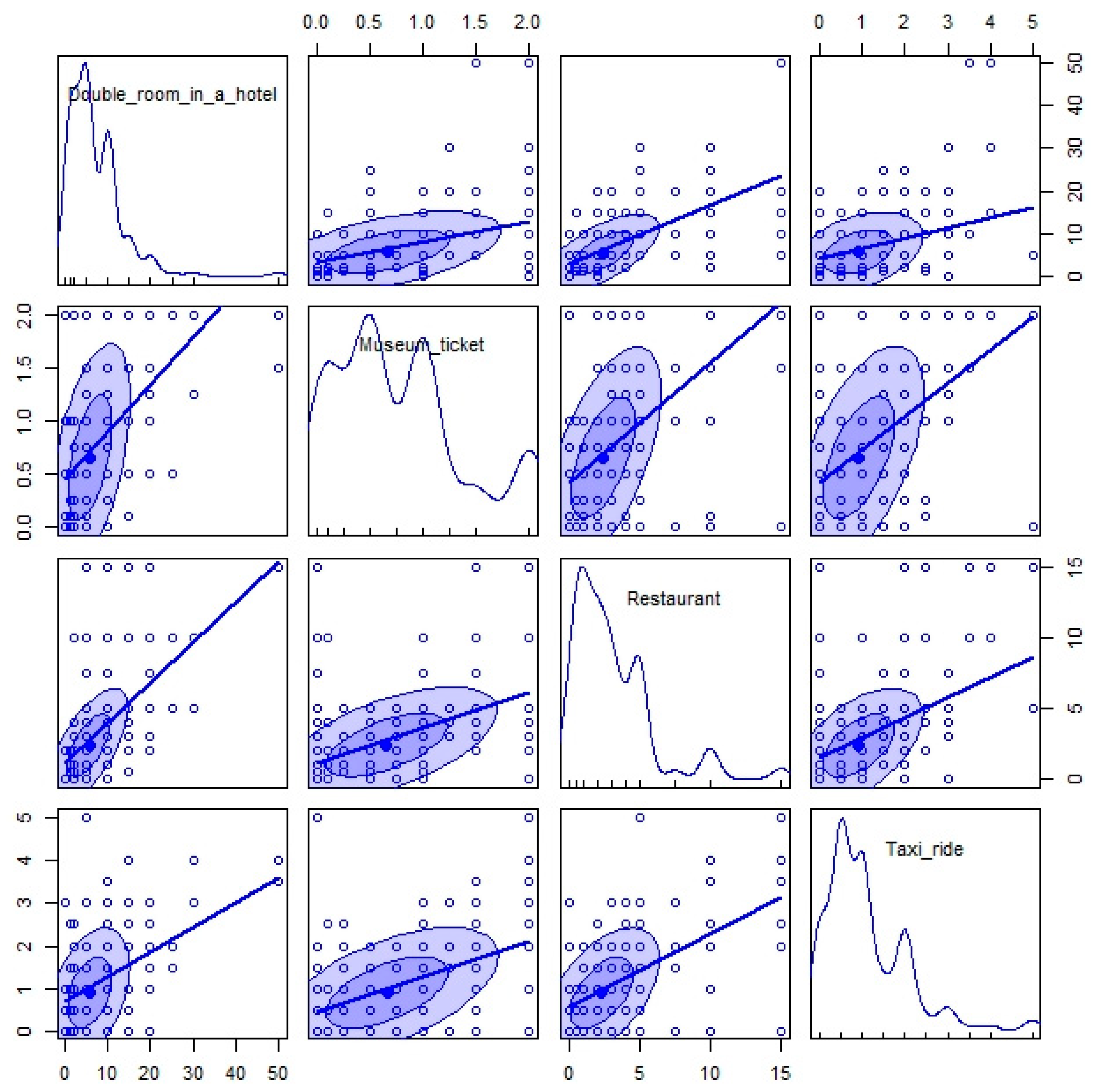
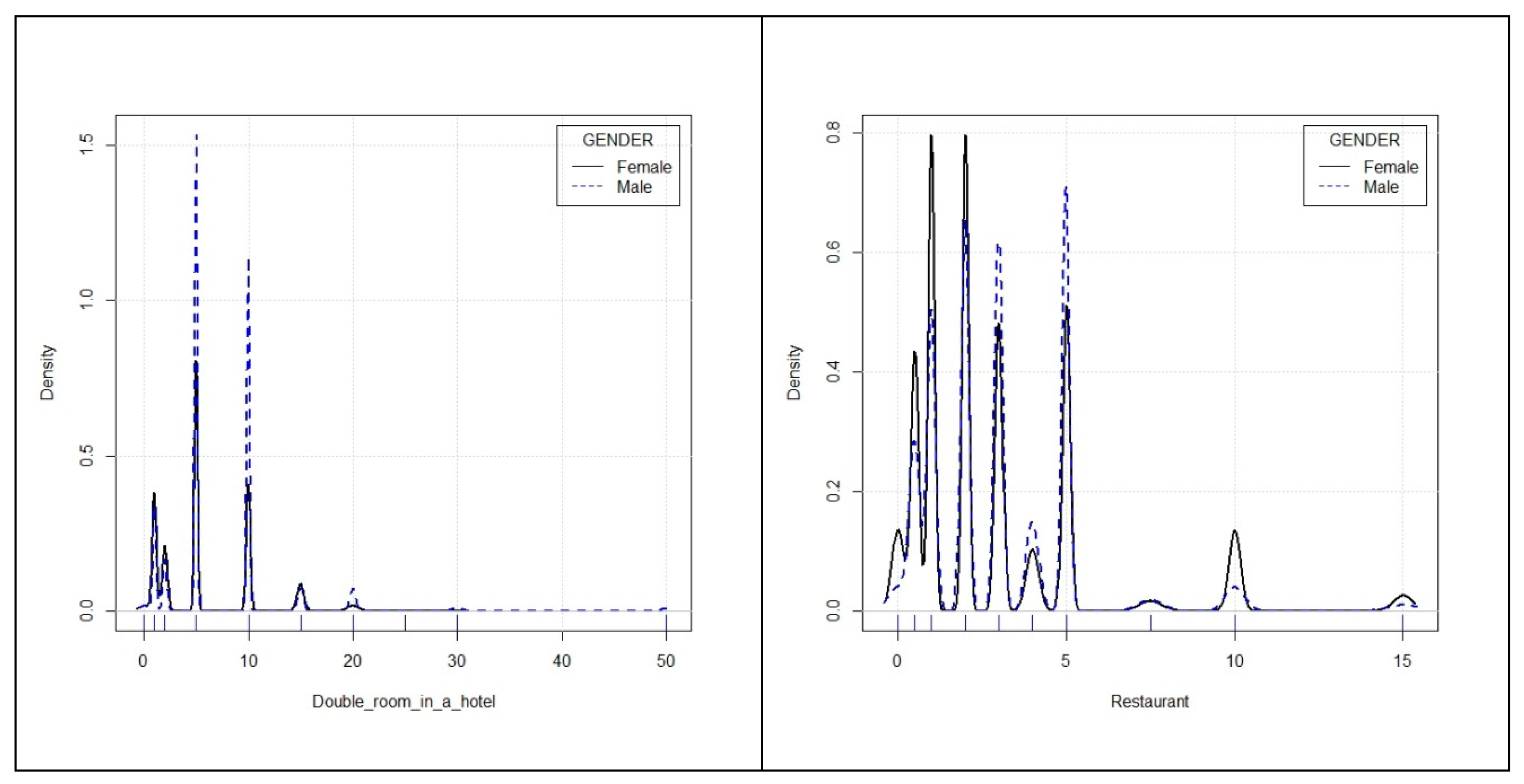
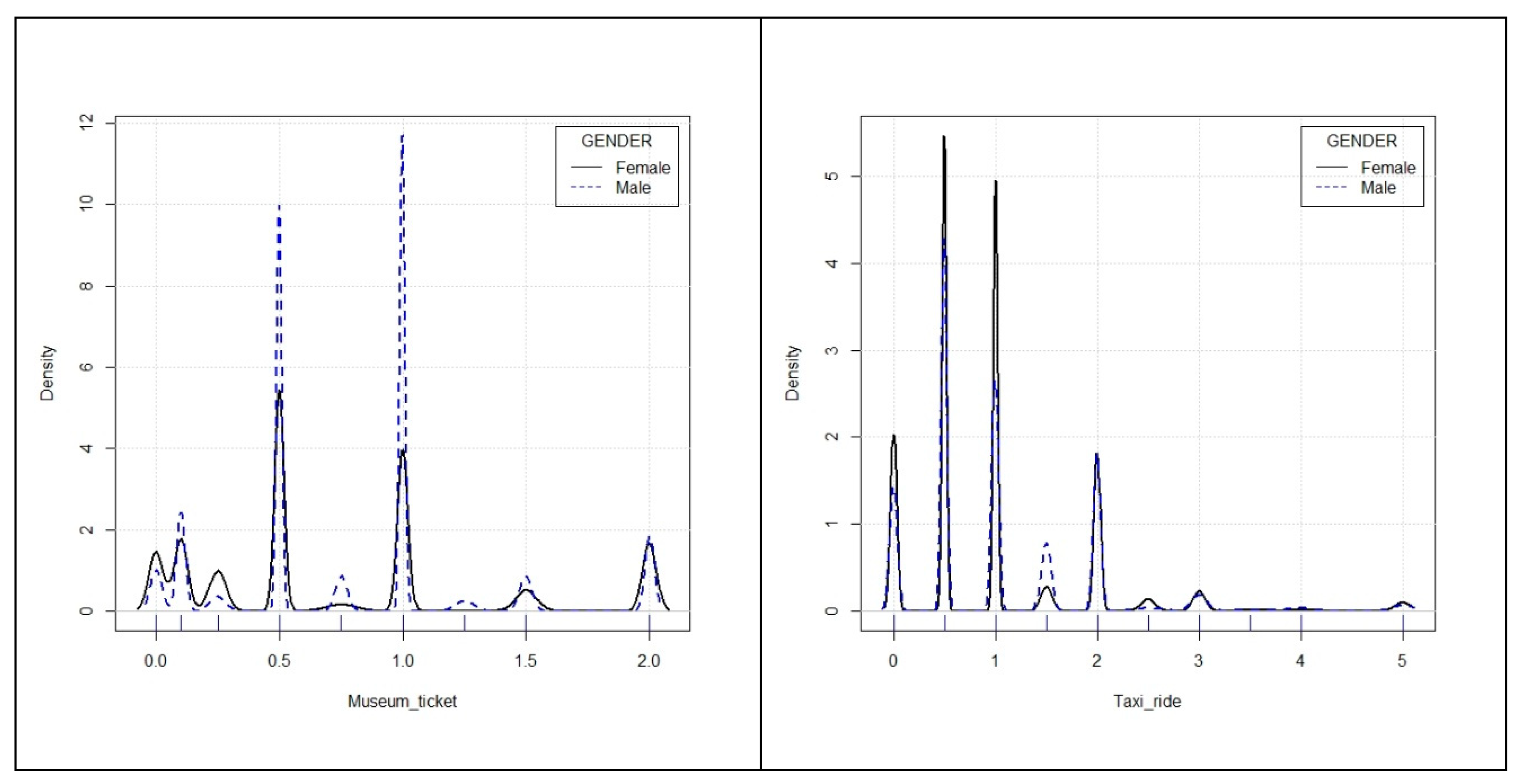
| Number of Establishments | Number of Places Offered | |
|---|---|---|
| - Hotels | 21 | 2138 |
| - Hostel | 9 | 209 |
| - Pension | 4 | 62 |
| - Rural accommodation | 1 | 4 |
| - Tourist apartments | 40 | 235 |
| - Tourist hostels | 2 | 105 |
| - Camping | 1 | 538 |
| Total accommodation | 78 | 3291 |
| - Restaurants | 173 | 11,827 |
| - Catering | 8 | 0 |
| - Banquet halls | 12 | 5858 |
| Total restoration | 193 | 17,685 |
| 2016 | 2017 | 2018 | |
|---|---|---|---|
| Annual number of tourists | 305,156 | 312,974 | 341,541 |
| Average number of tourists per month | 25,430 | 26,081 | 28,462 |
| Annual number of tourists per square kilometer | 174.3 | 178.8 | 195.1 |
| Average monthly tourist/local population ratio | 26.2% | 27.0% | 29.5% |
| Double Room in a Hotel | Restaurant | Museum Ticket | Taxi Ride | |
|---|---|---|---|---|
| - Mean | 6.78 | 2.98 | 0.75 | 1.09 |
| - Bounded mean (98%) | 6.55 | 2.91 | 0.75 | 1.06 |
| - Standard deviation | 6.23 | 2.77 | 0.59 | 0.98 |
| - IQR | 8.00 | 3.00 | 0.75 | 1.00 |
| - CV | 0.92 | 0.93 | 0.78 | 0.90 |
| - Skewness | 2.56 | 1.95 | 0.74 | 1.61 |
| - Kurtosis | 12.22 | 4.86 | −0.24 | 3.46 |
| - First quartile | 2.00 | 1.00 | 0.25 | 0.50 |
| - Median | 5.00 | 2.00 | 0.50 | 1.0 |
| - Third quartile | 10.00 | 4.00 | 1.00 | 1.5 |
| - Number of observations | 387 | 387 | 384 | 381 |
| - Missing data (NA) | 0 | 0 | 3 | 6 |
| Double Room in a Hotel | Restaurant | Museum Ticket | Taxi Ride | |
|---|---|---|---|---|
| Double room in a hotel | 1.000 | 0.6293 | 0.4620 | 0.3710 |
| (<0.0001) | (<0.0001) | (<0.0001) | ||
| Restaurant | 1.000 | 0.5308 | 0.4977 | |
| (<0.0001) | (<0.0001) | |||
| Museum ticket | 1.000 | 0.5061 | ||
| (<0.0001) | ||||
| Taxi ride | 1.000 |
| Double Room in a Hotel | Restaurant | Museum Ticket | Taxi Ride | |
|---|---|---|---|---|
| Factor: YEAR 1 = year 2012 2 = year 2016 | −2.6463 (1) | −1.9987 | −2.6949 | 1.3455 |
| 0.0008 (2) | 0.0463 | 0.0073 | 0.1793 | |
| −2.8976 (3) | −1.1129 | −0.2783 | −0.0625 | |
| −0.4228 (4) | −0.0091 | −0.0435 | 0.3333 | |
| 5.9427 (5) | 2.7005 | 0.6728 | 1.1559 | |
| 7.6051 (6) | 3.2615 | 0.8337 | 1.0205 | |
| Factor: ORIGIN 1 = national 2 = foreign | −2.8429 | −1.7324 | −1.5726 | −2.4883 |
| 0.0047 | 0.0840 | 0.1166 | 0.0132 | |
| −4.3875 | −1.5118 | −0.3082 | −0.6438 | |
| −0.7999 | 0.0955 | 0.0343 | −0.0755 | |
| 6.4252 | 2.8862 | 0.7347 | 1.0366 | |
| 9.0189 | 3.5943 | 0.8717 | 1.3962 | |
| Factor: GENDER 1 = female 2 = male | −2.3636 | −0.2095 | −1.1121 | −0.5347 |
| 0.0186 | 0.8342 | 0.2668 | 0.5932 | |
| −2.7854 | −0.6310 | −0.1892 | −0.2603 | |
| −0.2555 | 0.5095 | 0.0525 | 0.1490 | |
| 6.0594 | 2.9777 | 0.7251 | 1.0783 | |
| 7.5799 | 3.0385 | 0.7935 | 1.1339 |
| Double Room in a Hotel | Restaurant | Museum Ticket | Taxi Ride | |
|---|---|---|---|---|
| Factor: AGE 1 = from 18 to 25 2 = from 26 to 40 3 = from 41 to 55 4 = from 56 to 65 5 = over 65 | 0.307 (1) | 0.836 | 0.645 | 0.523 |
| 0.873 (2) | 0.503 | 0.631 | 0.719 | |
| 7.8846 (3) | 2.6346 | 0.7250 | 1.0000 | |
| 6.5702 (4) | 2.8058 | 0.6938 | 1.0455 | |
| 6.8837 (5) | 3.3566 | 0.8089 | 1.1457 | |
| 7.0274 (6) | 2.8630 | 0.7667 | 1.0352 | |
| 6.3529 (7) | 3.0000 | 0.7924 | 1.2656 | |
| Factor: EDUCATION 1 = no studies 2 = primary education 3 = secondary education 4 = higher education | 3.297 (1) | 1.837 | 4.812 | 3.519 |
| 0.021 (2) | 0.140 | 0.003 | 0.015 | |
| 4.2000 (3) | 2.3000 | 0.5400 | 0.3000 | |
| 4.5500 (4) | 2.0500 | 0.5225 | 0.6000 | |
| 5.9048 (5) | 2.7183 | 0.6452 | 0.9516 | |
| 7.5895 (6) | 3.2467 | 0.8491 | 1.1991 |
© 2019 by the authors. Licensee MDPI, Basel, Switzerland. This article is an open access article distributed under the terms and conditions of the Creative Commons Attribution (CC BY) license (http://creativecommons.org/licenses/by/4.0/).
Share and Cite
Jurado-Rivas, C.; Sánchez-Rivero, M. Willingness to Pay for More Sustainable Tourism Destinations in World Heritage Cities: The Case of Caceres, Spain. Sustainability 2019, 11, 5880. https://doi.org/10.3390/su11215880
Jurado-Rivas C, Sánchez-Rivero M. Willingness to Pay for More Sustainable Tourism Destinations in World Heritage Cities: The Case of Caceres, Spain. Sustainability. 2019; 11(21):5880. https://doi.org/10.3390/su11215880
Chicago/Turabian StyleJurado-Rivas, Carlos, and Marcelino Sánchez-Rivero. 2019. "Willingness to Pay for More Sustainable Tourism Destinations in World Heritage Cities: The Case of Caceres, Spain" Sustainability 11, no. 21: 5880. https://doi.org/10.3390/su11215880
APA StyleJurado-Rivas, C., & Sánchez-Rivero, M. (2019). Willingness to Pay for More Sustainable Tourism Destinations in World Heritage Cities: The Case of Caceres, Spain. Sustainability, 11(21), 5880. https://doi.org/10.3390/su11215880





